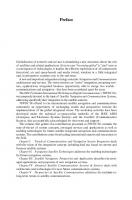Springer handbook of global navigation satellite systems 978-3-319-42926-7, 3319429264, 978-3-319-42928-1
786 160 24MB
English Pages 1328 [1335] Year 2017
Table of contents :
Content: Part A: Fundamentals of GNSS. .- Introduction to GNSS.- Time and Reference Systems.- Satellite Orbits and Attitude.- Signals and Modulation.- Clocks.- Atmospheric Signal Propagation.- Part B: Satellite Navigation Systems: .- The Global Positioning System (GPS).- GLONASS.- Galileo.- Chinese Navigation Satellite Systems.- Regional Systems.- Space Based Augmentation Systems.- Part C: GNSS Receivers and Architecture: .- Receiver Architecture.- Signal Processing.- Multipath.- Interference.- Antennas.- Simulators and Test Equipment.- Part D: GNSS Algorithms and Models: .- The Basic Observation Equations.- Combinations of Observations.- Positioning Model.- Least-Squares Estimation and Kalman Filtering.- Carrier Phase Integer Ambiguity Resolution.- Batch and Recursive Model Validation.- Part E: Positioning and Navigation: .- Precise Point Positioning.- Differential Positioning.- Attitude Determiantion.- GNSS/INS Integration.- Land and Marine Applications.- Aviation Applications.- Ground Based Augmentation Systems.- Space Applications.- The International GNSS Service.- Part F: Surveying, Geodesy and Geodynamics: .- Orbit and Clock Product Generation.- Surveying.- Geodesy.- Geodynamics.- Part G: GNSS Remote Sensing and Timing: .- Monitoring of the Neutral Atmosphere.- Ionospheric Monitoring.- Reflectometry.- GNSS Time and Frequency Transfer.- Appenidx: .- Data Formats.- GNSS Parameters.
Content: Part A: Fundamentals of GNSS. .- Introduction to GNSS.- Time and Reference Systems.- Satellite Orbits and Attitude.- Signals and Modulation.- Clocks.- Atmospheric Signal Propagation.- Part B: Satellite Navigation Systems: .- The Global Positioning System (GPS).- GLONASS.- Galileo.- Chinese Navigation Satellite Systems.- Regional Systems.- Space Based Augmentation Systems.- Part C: GNSS Receivers and Architecture: .- Receiver Architecture.- Signal Processing.- Multipath.- Interference.- Antennas.- Simulators and Test Equipment.- Part D: GNSS Algorithms and Models: .- The Basic Observation Equations.- Combinations of Observations.- Positioning Model.- Least-Squares Estimation and Kalman Filtering.- Carrier Phase Integer Ambiguity Resolution.- Batch and Recursive Model Validation.- Part E: Positioning and Navigation: .- Precise Point Positioning.- Differential Positioning.- Attitude Determiantion.- GNSS/INS Integration.- Land and Marine Applications.- Aviation Applications.- Ground Based Augmentation Systems.- Space Applications.- The International GNSS Service.- Part F: Surveying, Geodesy and Geodynamics: .- Orbit and Clock Product Generation.- Surveying.- Geodesy.- Geodynamics.- Part G: GNSS Remote Sensing and Timing: .- Monitoring of the Neutral Atmosphere.- Ionospheric Monitoring.- Reflectometry.- GNSS Time and Frequency Transfer.- Appenidx: .- Data Formats.- GNSS Parameters.

- Author / Uploaded
- Montenbruck
- Oliver; Teunissen
- Peter J. G (eds.)
- Similar Topics
- Technique
- Aerospace Equipment





![Global Navigation Satellite Systems: Report of a Joint Workshop of the National Academy of Engineering and the Chinese Academy of Engineering [1 ed.]
9780309222761, 9780309222754](https://ebin.pub/img/200x200/global-navigation-satellite-systems-report-of-a-joint-workshop-of-the-national-academy-of-engineering-and-the-chinese-academy-of-engineering-1nbsped-9780309222761-9780309222754.jpg)



![China Satellite Navigation Conference (CSNC 2021) Proceedings [3]
9789811631450, 9789811631467](https://ebin.pub/img/200x200/china-satellite-navigation-conference-csnc-2021-proceedings-3-9789811631450-9789811631467.jpg)